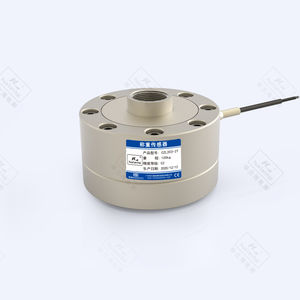
- Detection - Measurement
- Force Measurements
- Tension/compression load cell
- Guangdong South China Sea Electronic Measuring Tec
- Company
- Products
- Catalogs
- News & Trends
- Exhibitions
Tension/compression load cell CZL303S-beamstrain gaugenickel-plated

Add to favorites
Compare this product
Characteristics
- Type
- tension/compression
- Form
- S-beam
- Technology
- strain gauge
- Other characteristics
- steel construction, nickel-plated, IP67, IP68, IP66, waterproof, corrosion-resistant
- Rated load
Max.: 5 t
(5.51 us ton)Min.: 0.5 t
(0.55 us ton)
Description
S-type force sensor adopts S-type structure, which can be used for tension and compression; With advanced sealing technology, the sealing grade reaches IP65 and can work in high humidity environment; It has strong torsional, lateral and deflection resistance. It has single hole structure and double hole structure; There are bending deformation structure and shear deformation structure. This kind of sensor adopts high-quality elastic steel and foil strain gauge technology. It has better linearity and repeatability. The influence of zero point and sensitivity temperature of the sensor is compensated to ensure the long-term stability of the sensor.
Made of alloy steel, sealed by adhesive, plated by nickel, this model is waterproof, anti-corrosion at defend grade IP66 & IP68.
Accuracy class
C2
Comprehensive error
±0.03 & ±0.02% FS
Output sensitivity
2.0±0.002 mV/V
creep
±0.02% FS/30min
Zero output
±1.0% FS
Input impedance
350±10Ω
Output impedance
350±3Ω
insulation resistance
≥5000 MΩ(100VDC)
Influence of zero temperature
±0.02 & ±0.017% FS/10℃
Sensitivity temperature effect
±0.03 & ±0.014% FS/10℃
Temperature compensation range
-10℃ ~ +40 ℃
Operating temperature range
-30℃ ~ +70 ℃
Excitation voltage
10VDC ~ 12VDC
Safe overload range
120%
Limit overload range
150%
Catalogs
No catalogs are available for this product.
See all of Guangdong South China Sea Electronic Measuring Tec‘s catalogsOther Guangdong South China Sea Electronic Measuring Tec products
Load cell
Related Searches
- Force sensor
- Tension/compression force sensor
- Steel force transducer
- Strain gauge force transducer
- Stainless steel force sensor
- Weighing force sensor
- Beam type force transducer
- Compression force sensor
- IP67 force transducer
- Aluminum force sensor
- IP65 force sensor
- IP68 force sensor
- Shear beam load cell
- High-precision force sensor
- Hopper resistive load cell
- Button type force sensor
- Precision force sensor
- Miniature force transducer
- S-beam force sensor
- Canister force transducer
*Prices are pre-tax. They exclude delivery charges and customs duties and do not include additional charges for installation or activation options. Prices are indicative only and may vary by country, with changes to the cost of raw materials and exchange rates.


















